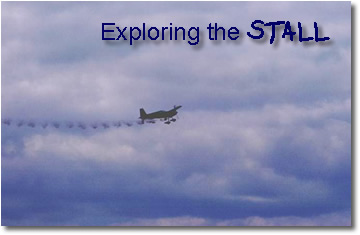 |
|
Exploring the Stall, Part II Some Advanced Stalls
“Experience
is a hard teacher because she gives the test first, the lesson afterward.” Last time we explored some aspects of the basic, level power off stall. Of course, we never want to stall an aircraft unintentionally at any time, but having a good understanding of the stall characteristics and the symptoms leading up to the stall for the aircraft you are flying can be information that might save your life. We
discussed that an aircraft wing stalls at a particular angle of attack.
That’s the whole story. The stall is not a function of airspeed,
although we commonly practice stall entry at low airspeed, nor is it a
function of attitude, although we generally associate the stall with a
nose up attitude as a result of our training sessions. A stall happens
because the angle of attack of the wing—the angle between the chord
line of the wing and the relative wind—has exceeded the critical
angle. We discussed the symptoms of the approaching stall and the importance of knowing and recognizing them before the actual stall arrives so we can make a decision about whether or not we choose to allow the aircraft to stall. What are we looking, feeling, for? Loss of positive control responses, the buffet caused by roiled air striking the horizontal stabiliser, perhaps the stall warning horn or light if the aircraft is so equipped. At the stall itself, of course, the nose will drop as we lose lift and control response, but unless we are performing a stall on purpose we’d like to recognize its approach and solve the problem before it occurs. It’s like knowing, in the dark, where the edge of a curb is. If you know exactly where the edge is you can approach it with confidence; if you are unsure, you may well step over by mistake and find yourself in trouble. More advanced stalls, rather than the basic, level stall are, generally, the ones that get pilots into trouble. They arrive while we are doing something else, like trying to avoid trees, or check out the babes on the beach, or losing an engine on takeoff, or, perhaps, trying to turn at in a confined area. We won’t even discuss getting into trouble as a result of attempting to prove that you’re just as good as Patty Wagstaff. Let’s take a look at three of the advanced stalls that typically are associated with difficulties: the departure stall, the arrival stall and the accelerated stall. The departure stall results from pulling too hard into a climb. Some of the frequent causes of this type of stall are avoiding obstacles on take off or in low level flight, avoiding birds or other aircraft, showing off, windshear, wing contamination or becoming distracted and allowing airspeed to decay unnoticed followed by an abrupt change in attitude. The guidance notes for flight instructors gives a description of a typical departure stall accident: “Location: 1,100’ grass strip with 75’ high pine trees at departure end of the runway. The departing C-150 was observed by witnesses to become airborne approximately 200’ from the end of the strip and approximately 500’ from a line of pine trees off the departure end of the strip. The a/c entered a steep climbing right turn then rolled to the left and descended in a steep nose down attitude until it collided with the ground. 2 fatal.” The pilot, seeing that he or she would not be able to clear the trees, attempted to increase the climb by pulling back on the control column. The aircraft reached and exceeded its critical angle of attack and stalled. At the same time as the pilot pulled back he or she entered a turn to the right. The aircraft stalled, dropped its high wing, because that wing will have had a slightly higher angle of attack than the lower wing so will stall first, and spun to the left. From 200’ the pilot will not have had the necessary altitude to recover from the spin. At 3000’ a departure stall can be a surprising event, if you are not prepared. At 200’, it is too often fatal. If you haven’t practiced one since your flight test, it’s not a bad plan to find a safe altitude in a safe location and try a few for practice. If you’re not certain of the whole idea, take your friendly, local flight instructor up with you. The important thing is to know and recognize the symptoms of the stall’s approach. A little work with your aircraft’s POH regarding obstacle clearance takeoffs isn’t a totally bad plan, either. The arrival stall, sometimes described as a descending, turning stall, results when a pilot, normally at low level, possibly on final approach or turning base to final, allows the airspeed to decay and some yaw to develop. Some typical scenarios for the arrival stall are turning to correct for an overshoot of the extended runway centreline; turning to avoid obstacles, birds or other aircraft; attempting to stretch a glide to the runway by raising the nose and not applying power; illusions in strong wind conditions; and distraction resulting in airspeed decay. From the guidance notes we have an example: “Location: 1 mile east of Fairfax aerodrome. Weather conditions: VFR, winds NW at 15 Kts., moderate turbulence. The Piper Cub J-3 overshot the extended centreline for runway 26 while turning final. Witnesses observed the a/c turning from south to the west at a moderate bank angle. Prior to completion of the turn the a/c bank attitude increased rapidly and the nose dropped to a nearly vertical attitude. The wreckage impact was consistent with an a/c in a spin condition. 1 fatal.” At 3000’, or whatever might be required for safe altitude, some practice will show you the edges of your own aircraft’s descending turn stall. You will see and come to recognize the approaching symptoms so you will never do one at low level when the results will not be just a bit of a surprise. Unlike the departure stall, in a descending, turning stall the inside or down wing will stall first. It is traveling slightly slower through the air and reaches its critical angle of attack before the up wing, leading to a spin in the direction of the turn. It is slightly less dramatic than the departure stall but can be no less fatal if is occurs at the wrong time in the wrong place. An accelerated stall is frequently entered from a level turn and results from, as with all stalls, too high an angle of attack. The added factor we must consider with an accelerated stall is the increased wing loading or load factor resulting from acceleration. In a turn, we are accelerating and the loading on the wings is increased by a function of the angle of bank. Without beating the math to death, we might remember from ground school that a 45? bank turn produces a 1.41g loading; a 60? bank turn produces a 2g loading and a 75? bank turn results in a 4g loading. We can look these values up and save ourselves some effort, or we can work them out ourselves. We can derive them either mathematically or geometrically. Mathematically, we find that G = 1/cos ? (where ? = the angle of bank). One divided by the cosine of our angle of bank is the multiplier of our weight to find live load or “G” force. The stall speed, we may also remember, increases by the square root of the “G” force, or load factor on the aircraft so that, in a 60? bank turn our stall speed increases by the square root of 2: 1.41. If your normal, non-accelerated stall speed in level flight is 50 Kts., your stall speed in a 60? bank turn will be 70.7 Kts. When might an accelerated stall occur? Typically the pilot sightseeing at low level, the pilot turning to look at landmarks, wildlife, people (remember those babes on the beach?), or turning to avoid obstacles or aircraft may produce the necessary conditions. A classic example is provided in the instructor guidelines: “Location: 2 miles west of Clarence Lake. Weather conditions: VFR. The Cessna 210 with 3 persons onboard was observed to be flying at tree top level and manoeuvring in an abrupt manner. A video camera recovered from the wreckage recorded the final minutes of the flight. The pilot was manoeuvring to allow a passenger to video tape a moose when the stall warning horn activated and the a/c stalled in a 45? left bank turn at an altitude of 50 feet AGL. 3 fatal.” Practicing stalls so you can learn, understand and know the stall characteristics of your aircraft will give you a sense of control and security. You will know where the edge is and will be able to approach it with confidence. You will know the symptoms of the approaching stall and know how and when to modify your inputs to either produce or avoid the stall as required. Don’t allow that surprise, unplanned stall to be the first one of its type you experience. Under safe, controlled conditions at a comfortable altitude is an excellent place to practice some advanced stalls so the symptoms and indications are clear and fresh in your mind and body and the recovery procedures are also second nature. It might just save your life and the lives of those who put their trust in you to pilot them safely. OK. It’s also a bit of fun. |



